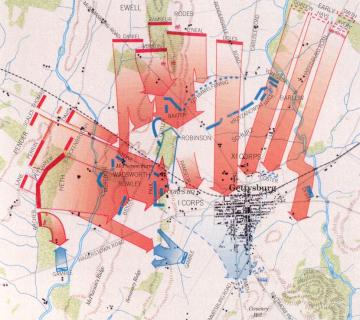

 Union Major General Oliver O. Howard took over command of the battlefield, from Major General Abner Doubleday who replaced the fallen Reynolds, somewhere between 9:45 and 11:30. Howard had witnessed Cutler's brigade fall back. His biggest concern at this time, since fighting had died down for a time west of town, were the reports that fresh Confederate infantry were expected from the north at any time. When the 11th Corps came up, Howard sent them north of town. It was noon when Confederate Major General Rodes division, of Ewell's Corps, arrived from the north deploying from Oak Hill and hurriedly tried to out flank the Federal line. Howard sent the 2nd Division of his 2nd Corps, which he had been holding in reserve, in north of the Chambersburg Pike to counter this new threat. Rodes was in such a hurry that he did not take time to do a proper reconnaissance of the field, nor did he send his brigades into the fight in a coordinated effort. Initially Rodes division was held off, suffered high causalities, Rodes's staff was beginning to look for ways to keep the conflict from becoming a disaster when to their left Confederate Major General Jubal A. Early's division arrived also of Ewell's Corps.  The view from the Confederate artillery position on Oak HillEarly's division hit and out flanked the right of the Federal 11th Corps. Just as the 11th Corps's right was being turned, Rodes division found a weak point in the 2nd Corps line and punched through. The soldiers of the Federal 11th Corps seeing that both of their flanks were in danger, did the same thing that they had done at Chancellorsville two months earlier, when they had been in a similar situation. They ran! General Lee now watching from Herr Ridge across the valley from Seminary Ridge sent the balance of Hill's Corps forward, Pender's and Heth's divisions. Although they met stiff resistance at the Lutheran Seminary for which the ridge is named, with the rear of the Yankees defending Seminary Ridge being threatened by the advancing Early, the Federals there too began a withdrawal.  The demoralized Federal army streamed through the town. They probably would have kept right on running had there not been Federal guns placed on heights south of the town. These heights, Cemetery Hill named for the cemetery there, was chosen either by Reynolds or by Howard as a place to fall back onto. Even then they might have kept right on running except that Federal Major General Winfield Scott Hancock was now on the scene. The retreating troops seeing Hancock, who inspired confidence not just in common soldiers but also in his commanders, began to reorganize. The next series of pictures were taken from an observation tower built in the early part of the 20th century, this one is located just out of frame left from the first picture on this page. These pictures start looking north and then pan east to the town of Gettysburg. In the picture on the lower left is Barlow Knoll, it is located in the group of trees that is in front of the broadcast tower on the left side of the picture. | |||||||||
| |||||||||
|
My motel in Gettysburg was located on the south side of town almost where the Emmitsburg Road and the Baltimore Pike meet, at the base of Cemetery Hill. One evening as I'm walking back to my motel after being downtown, there was a moment of quiet on the street. I thought that I could hear shouting in the street behind me. I stopped in my tracks, spun around and looked back down the Baltimore Street at where I had just been. At that moment I was transported back in time to the late afternoon of July 1st, 1863. The Union Army was falling back on their reserves on Cemetery Hill. I could see Yankees running up the street, stopping long enough to turn and fire down the street at the approaching Rebels. As the Yankees passed me, I could hear the crack of the Rebel muskets and the whiz of their musketballs in the air around me. There were dead and dying men moaning in the street. Just as suddenly as these images at hit me, they were gone, when a car with music playing full blast drove by and brought me back from 137 years in the past. It had been one of those rare moments that I would have in Gettysburg, but a moment I had driven 850 miles to have. | |||||||||
 |
 | ||||||||